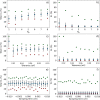Swarm Smart Meta-Estimator for 2D/2D Heterostructure Design
- PMID: 37796976
- PMCID: PMC10598791
- DOI: 10.1021/acs.jcim.3c01509
Swarm Smart Meta-Estimator for 2D/2D Heterostructure Design
Abstract
Two-dimensional (2D) semiconductors are central to many scientific fields. The combination of two semiconductors (heterostructure) is a good way to lift many technological deadlocks. Although ab initio calculations are useful to study physical properties of these composites, their application is limited to few heterostructure samples. Herein, we use machine learning to predict key characteristics of 2D materials to select relevant candidates for heterostructure building. First, a label space is created with engineered labels relating to atomic charge and ion spatial distribution. Then, a meta-estimator is designed to predict label values of heterostructure samples having a defined band alignment (descriptor). To this end, independently trained k-nearest neighbors (KNN) regression models are combined to boost the regression. Then, swarm intelligence principles are used, along with the boosted estimator's results, to further refine the regression. This new "swarm smart" algorithm is a powerful and versatile tool to select, among experimentally existing, computationally studied, and not yet discovered van der Waals heterostructures, the most likely candidate materials to face the scientific challenges ahead.
Conflict of interest statement
The authors declare no competing financial interest.
Figures





References
-
- Cudazzo P.; Tokatly I. V.; Rubio A. Dielectric screening in two-dimensional insulators: Implications for excitonic and impurity states in graphane. Phys. Rev. B: Condens. Matter Mater. Phys. 2011, 84, 085406.10.1103/PhysRevB.84.085406. - DOI
-
- Hüser F.; Olsen T.; Thygesen K. S. How dielectric screening in two-dimensional crystals affects the convergence of excited-state calculations: Monolayer MoS2. Phys. Rev. B: Condens. Matter Mater. Phys. 2013, 88, 245309.10.1103/PhysRevB.88.245309. - DOI
Publication types
MeSH terms
LinkOut - more resources
Full Text Sources

